Udaipur Day Tours
Eklingji Temple
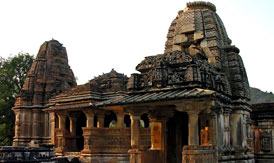 Eklingji Temple is one of the most famous temples of Rajasthan. Located in the town of Eklingji (Kailashpuri), the place got its popular name from the temple. Eklingji Temple is positioned at a distance of 22 km in the north of Udaipur, on the national highway no. 8. Eklingnath Temple is dedicated to the Lord Shiva of the Hindu religion. Initially, the temple was built in 734 A.D. by Bappa Rawal. Since that time, Eklingji has been the ruling deity of Mewar rulers. In the later years, it was repaired and modified by various Kings, to clean the remnants of obliteration made by the attacks of Mohammedans. The magnificent architecture of Eklingnath Temple is simply remarkable. The double-storied temple looks awesome with its pyramidal style of roof and distinctly carved tower. The outer walls of the temple are stretched with steps that descend touching the serene waters. Inside the complex, the main temple is a huge pillared hall or 'mandap' that is sheltered by hefty pyramidal roof.
Eklingji Temple is one of the most famous temples of Rajasthan. Located in the town of Eklingji (Kailashpuri), the place got its popular name from the temple. Eklingji Temple is positioned at a distance of 22 km in the north of Udaipur, on the national highway no. 8. Eklingnath Temple is dedicated to the Lord Shiva of the Hindu religion. Initially, the temple was built in 734 A.D. by Bappa Rawal. Since that time, Eklingji has been the ruling deity of Mewar rulers. In the later years, it was repaired and modified by various Kings, to clean the remnants of obliteration made by the attacks of Mohammedans. The magnificent architecture of Eklingnath Temple is simply remarkable. The double-storied temple looks awesome with its pyramidal style of roof and distinctly carved tower. The outer walls of the temple are stretched with steps that descend touching the serene waters. Inside the complex, the main temple is a huge pillared hall or 'mandap' that is sheltered by hefty pyramidal roof.
Saas – Bahu Temple
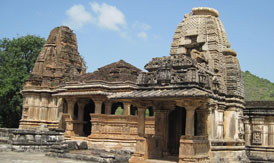 Nagda is a small town in the Indian state of Rajasthan. In the 6th century, Nagda was found by Nagaditya, the fourth Mewar King. Initially it was known as Nagahrida and served as the capital of Mewar. Before long, the place came under the province of Sisodias. Nagda is located besides Bagela Lake at a distance of 23 kms in the north-west of Udaipur on the way to Nathdwara. Nagda comprises many small and big temples, but the main attraction is gained by its 'Sas-Bahu' temple. Nagda is actually famous for this unusual temple that dates back to the 10th century. The term 'Sas-Bahu' suggests 'Mother-in-law and Daughter-in-law' respectively. The temple is dedicated to Lord Vishnu and it is made in two structures, one by a mother-in-law and another, by a daughter-in-law. The main entrance to the temples is made through a door that has carved lintels and a multi-lobed arch in its middle. Both the structures are laid out on a same plan having an altar, a mandapa (columned prayer hall) with projections and a porch.
Nagda is a small town in the Indian state of Rajasthan. In the 6th century, Nagda was found by Nagaditya, the fourth Mewar King. Initially it was known as Nagahrida and served as the capital of Mewar. Before long, the place came under the province of Sisodias. Nagda is located besides Bagela Lake at a distance of 23 kms in the north-west of Udaipur on the way to Nathdwara. Nagda comprises many small and big temples, but the main attraction is gained by its 'Sas-Bahu' temple. Nagda is actually famous for this unusual temple that dates back to the 10th century. The term 'Sas-Bahu' suggests 'Mother-in-law and Daughter-in-law' respectively. The temple is dedicated to Lord Vishnu and it is made in two structures, one by a mother-in-law and another, by a daughter-in-law. The main entrance to the temples is made through a door that has carved lintels and a multi-lobed arch in its middle. Both the structures are laid out on a same plan having an altar, a mandapa (columned prayer hall) with projections and a porch.
Nathdwara Shrinathji Temple
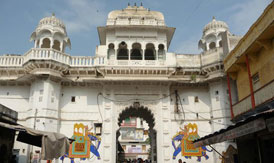 Nathdwara is a small town in the Indian state of Rajasthan. Situated at a distance of 48kms in the north-east of Udaipur, Nathdwara is sited on the right bank of Banas River. Nathdwara is famous for its 17th century temple that is dedicated to Lord Shrinathji (Lord Krishna). The term 'Nathdwara' suggests the 'gate of the lord'. Shrinathji Temple is also known as 'Haveli of Shrinathji' and makes a prominent pilgrimage of the Hindus / Vaishnavas. The temple has a story behind its establishment. According to the legend, the image of Lord Shrinath ji was enshrined in Vrindavan (land of Lord Krishna), but to protect the idol from the destructive rage of Aurangzeb. In 1672, Rana Raj Singh was the only gallant, who made an effort to rescue the idol from the domain of Aurangzeb. It is said that when the image was being shifted to an impervious place then at a particular place, the wheel of vehicle sank deep down in mud.
Nathdwara is a small town in the Indian state of Rajasthan. Situated at a distance of 48kms in the north-east of Udaipur, Nathdwara is sited on the right bank of Banas River. Nathdwara is famous for its 17th century temple that is dedicated to Lord Shrinathji (Lord Krishna). The term 'Nathdwara' suggests the 'gate of the lord'. Shrinathji Temple is also known as 'Haveli of Shrinathji' and makes a prominent pilgrimage of the Hindus / Vaishnavas. The temple has a story behind its establishment. According to the legend, the image of Lord Shrinath ji was enshrined in Vrindavan (land of Lord Krishna), but to protect the idol from the destructive rage of Aurangzeb. In 1672, Rana Raj Singh was the only gallant, who made an effort to rescue the idol from the domain of Aurangzeb. It is said that when the image was being shifted to an impervious place then at a particular place, the wheel of vehicle sank deep down in mud.
Kumbhalgarh Fort
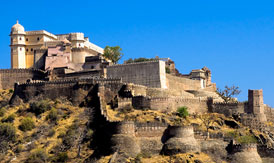 Kumbhalgarh Fort is the second most important fort of Rajasthan after Chittorgarh. Located at a distance of 64 kms from Udaipur in Rajasmand district, Kumbhalgarh Fort is easily accessible from the city of Udaipur. This unconquerable fortress is secured under the kind protection of the Aravali ranges. Kumbhalgarh Fort was built by Maharana Rana Kumbha in the 15th century. The fort derived its name from the same factor. Encircled by thirteen elevated mountain peaks, the fort is constructed on the top most ridges around 1,914 meters above sea level. The fortifications of the fort extend to the length of 36 kilometers and this fact has made this fort to be in the international records. It is stated to be the second longest wall in the world, the first being ''the Great Wall of China''. The huge complex of the Fort has numerous palaces, temples and gardens making it more magnificent.
Kumbhalgarh Fort is the second most important fort of Rajasthan after Chittorgarh. Located at a distance of 64 kms from Udaipur in Rajasmand district, Kumbhalgarh Fort is easily accessible from the city of Udaipur. This unconquerable fortress is secured under the kind protection of the Aravali ranges. Kumbhalgarh Fort was built by Maharana Rana Kumbha in the 15th century. The fort derived its name from the same factor. Encircled by thirteen elevated mountain peaks, the fort is constructed on the top most ridges around 1,914 meters above sea level. The fortifications of the fort extend to the length of 36 kilometers and this fact has made this fort to be in the international records. It is stated to be the second longest wall in the world, the first being ''the Great Wall of China''. The huge complex of the Fort has numerous palaces, temples and gardens making it more magnificent.
Ranakpur Jain Temples
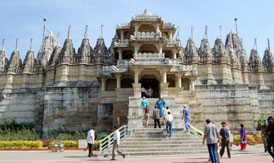 Ranakpur Temples are acclaimed world-wide for their intricate and superb architectural style. These temples form one of the five major pilgrimages of the Jains. Located in village of Ranakpur near Sadri town in the Pali district of Rajasthan, Ranakpur temple lies at a distance of 95 kms in the north of Udaipur city. The temple is easily accessible from the city of Udaipur as regular buses are easily available. Built in the 15th century, Ranakpur temples are known for being the largest and most important temples of the Jain cult. The temple is said to have been built by Seth Dharna Sah (a Jain businessman) with the aid of Rana Kumbha, who ruled Mewar in the 15th century. Ranakpur got its name after the name of the Rajput Monarch and likewise the temples. The temple complex is positioned in an isolated valley on the western side of the Aravalli Range. The Jain Temples of Ranakpur are certainly creditable for their splendid architecture. This temple is wholly constructed in light colored marble and comprises a basement covering an area of 48000 sq feet. There are more than 1400 exquisitely carved pillars that support the temple.
Ranakpur Temples are acclaimed world-wide for their intricate and superb architectural style. These temples form one of the five major pilgrimages of the Jains. Located in village of Ranakpur near Sadri town in the Pali district of Rajasthan, Ranakpur temple lies at a distance of 95 kms in the north of Udaipur city. The temple is easily accessible from the city of Udaipur as regular buses are easily available. Built in the 15th century, Ranakpur temples are known for being the largest and most important temples of the Jain cult. The temple is said to have been built by Seth Dharna Sah (a Jain businessman) with the aid of Rana Kumbha, who ruled Mewar in the 15th century. Ranakpur got its name after the name of the Rajput Monarch and likewise the temples. The temple complex is positioned in an isolated valley on the western side of the Aravalli Range. The Jain Temples of Ranakpur are certainly creditable for their splendid architecture. This temple is wholly constructed in light colored marble and comprises a basement covering an area of 48000 sq feet. There are more than 1400 exquisitely carved pillars that support the temple.
Chittorgarh Fort
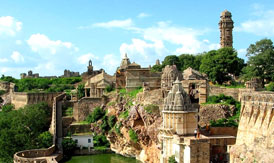 Chittorgarh Fort has received the credit of being the largest fort of India. The massive fort is located on a high hill near the Gambheri River in Chittorgarh. Chittorgarh Fort lies at a distance of 112 kms from the city of Udaipur in Rajasthan. This fort was built by various Maurya rulers in the 7th century. This huge fort covers an area of 700 acres, extending to 3 kms in length and 13 kms in peripheral length. Standing on an elevated hill of 180m, the impregnable fort has witnessed three battles. Chittaurgarh Fort is truly an embodiment of chivalry and pride of the Rajputs. The fort has a long story of romance, courage, determination and sacrifice. A glimpse of the fort still makes one to think the glory of the Rajputs who once lived here. The imposing Fort boasts of well-designed palaces, magnificent cenotaphs and huge towers. The Fort of Chittorgarh has a colossal structure that is secured by its several strong gateways.
Chittorgarh Fort has received the credit of being the largest fort of India. The massive fort is located on a high hill near the Gambheri River in Chittorgarh. Chittorgarh Fort lies at a distance of 112 kms from the city of Udaipur in Rajasthan. This fort was built by various Maurya rulers in the 7th century. This huge fort covers an area of 700 acres, extending to 3 kms in length and 13 kms in peripheral length. Standing on an elevated hill of 180m, the impregnable fort has witnessed three battles. Chittaurgarh Fort is truly an embodiment of chivalry and pride of the Rajputs. The fort has a long story of romance, courage, determination and sacrifice. A glimpse of the fort still makes one to think the glory of the Rajputs who once lived here. The imposing Fort boasts of well-designed palaces, magnificent cenotaphs and huge towers. The Fort of Chittorgarh has a colossal structure that is secured by its several strong gateways.
Haldighati
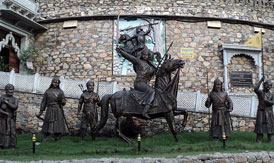 The pride of Rajsamand District, “Haldighati” in known across the globe for the chivalrous deeds of the great Maharana Pratap. 44 kilometers from Udaipur and 17 kilometers from Nathdwara it is nestled in the middle of the Aravali range. This narrow turmeric coloured mountainous region which played a stellar role in defending the honour of Mewar dynasty, is known as Haldighati. When Mughal commander attacked this region but had to beat retreat having been licked by the forces led by Maharana Pratap . Employing the guerilla warfare technique, the Rajput forces pushed the Mughals from the royal camp at Badshah Baag to open plains of Rakt Talai (Village Khamnor ). Accustomed to warfare in open plains, the mughal forces fought with Pratap but the outcome was indecisive. Maharana Pratap, astride his favourite stead “CHETAK” attacked Man singh with his spear killed the mahout while Man Singh managed to escape. During the encounter, one of Chetak’s hind legs was wounded from sword held in the elephant’s trunk creating an emergency.
The pride of Rajsamand District, “Haldighati” in known across the globe for the chivalrous deeds of the great Maharana Pratap. 44 kilometers from Udaipur and 17 kilometers from Nathdwara it is nestled in the middle of the Aravali range. This narrow turmeric coloured mountainous region which played a stellar role in defending the honour of Mewar dynasty, is known as Haldighati. When Mughal commander attacked this region but had to beat retreat having been licked by the forces led by Maharana Pratap . Employing the guerilla warfare technique, the Rajput forces pushed the Mughals from the royal camp at Badshah Baag to open plains of Rakt Talai (Village Khamnor ). Accustomed to warfare in open plains, the mughal forces fought with Pratap but the outcome was indecisive. Maharana Pratap, astride his favourite stead “CHETAK” attacked Man singh with his spear killed the mahout while Man Singh managed to escape. During the encounter, one of Chetak’s hind legs was wounded from sword held in the elephant’s trunk creating an emergency.